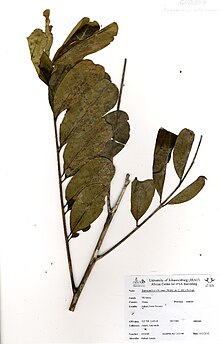| Turraeanthus africanus | |
|---|---|

| |
| Herbarium specimen of Turraeanthus africanus collected in Ankasa Forest Reserve, Ghana | |
| Conservation status | |
 Vulnerable (IUCN 3.1) | |
| Scientific classification | |
| Kingdom: | Plantae |
| Clade: | Tracheophytes |
| Clade: | Angiosperms |
| Clade: | Eudicots |
| Clade: | Rosids |
| Order: | Sapindales |
| Family: | Meliaceae |
| Genus: | Turraeanthus |
| Species: | T. africanus |
| Binomial name | |
| Turraeanthus africanus (Welw. ex C.DC.) Pellegr. | |
| Synonyms | |
Turraeanthus africanus is a species of plant in the family Meliaceae, also known by the common names avodiré, apeya, engan, agbe, lusamba, wansenwa, African satinwood, and African white mahogany.
Nomenclature
Although the species epithet given by François Pellegrin in the first publication is africana, it should be amended into masculine form, i.e. africanus per the ICN (ed. 2017, Art. 62.2 (c)): "Compounds ending in ‑ceras, ‑dendron, ‑nema, ‑stigma, ‑stoma, and other neuter words, are neuter. An exception is made for names ending in ‑anthos (or ‑anthus), ‑chilos (‑chilus or ‑cheilos), and ‑phykos (‑phycos or ‑phycus), which ought to be neuter, because that is the gender of the Greek words άνθος, anthos, χείλος, cheilos, and φύκος, phykos, but are treated as masculine in accordance with tradition."
Description
The species is found in Angola, Benin, Cameroon, the Democratic Republic of the Congo, Ivory Coast, Equatorial Guinea, Ghana, Nigeria, Sierra Leone, and Uganda. The genus name is derived from the botanist Turra (1607-1688) of Padua, Italy and anthos, a Greek word meaning flower.
Turraeanthus africanus is described as a tree of the rain forest, typically 115 ft (35 m), and having a trunk diameter of 2 to 3 ft (0.61 to 0.91 m). The wood of this tree has a specific gravity of 0.48. It is commonly creamy white or pale yellow but will darken upon exposure to ultra-violet light to a golden yellow color. It has an interlocked wood grain producing various figures: striped, curly, or mottled.
Uses
Avodire wood has long been valued in furniture for its naturally lustrous surface, which has led to the name African Satinwood. Commonly, the highly figured wood is used for veneers in panelling and marquetry.
A preparation from the bark of this plant is used by Baka people in southeastern Cameroon to stun fish.
Conservation
It listed on the IUCN Red List as vulnerable, and is threatened by habitat loss.
References
- Barstow, M. (2020). "Turraeanthus africana". IUCN Red List of Threatened Species. 2020: e.T33064A69047658. doi:10.2305/IUCN.UK.2020-3.RLTS.T33064A69047658.en.
- "Turraeanthus africanus". Plants of the World Online. Royal Botanic Gardens, Kew. Retrieved 16 July 2024.
- "Avodire | The Wood Database - Lumber Identification (Hardwood)". www.wood-database.com. Retrieved 2017-07-18.
- Pellegrin, F. (1911). "Contribution à l'étude de la Flore de l'Afrique occidentale: Méliacées". Notulae Systematicae. 2: 68.
- Article 62, International Code of Nomenclature for algae, fungi, and plants (Shenzhen Code). Accessed: 17 June 2021.
- James H. Flynn and Charles D. Holder, Eds. A Guide to Useful Woods of the World, second edition, page 546, Forest Products Society, 2001
- United States Department of Agriculture."The Encyclopedia of Wood", page 1-18.Skyhorse Publishing, Inc.,2007
- Terry Porter: "Wood Identification and Use", page 224. Guild of Master Craftsman Publications Ltd. 2004
- HUNTING ACTIVITIES IN FOREST CAMPS AMONG THE BAKA HUNTER-GATHERERS OF SOUTHEASTERN CAMEROON, African Study Monographs, 29(2): 73-92, July 2008
| Taxon identifiers | |
|---|---|
| Turraeanthus africanus |
|
This Meliaceae-related article is a stub. You can help Misplaced Pages by expanding it. |
- IUCN Red List vulnerable species
- Turraeanthus
- Trees of Africa
- Flora of Angola
- Flora of Benin
- Flora of Cameroon
- Flora of the Democratic Republic of the Congo
- Flora of Ivory Coast
- Flora of Equatorial Guinea
- Flora of Ghana
- Flora of Nigeria
- Flora of Sierra Leone
- Flora of Uganda
- Vulnerable flora of Africa
- Plants described in 1878
- Taxa named by Friedrich Welwitsch
- Meliaceae stubs